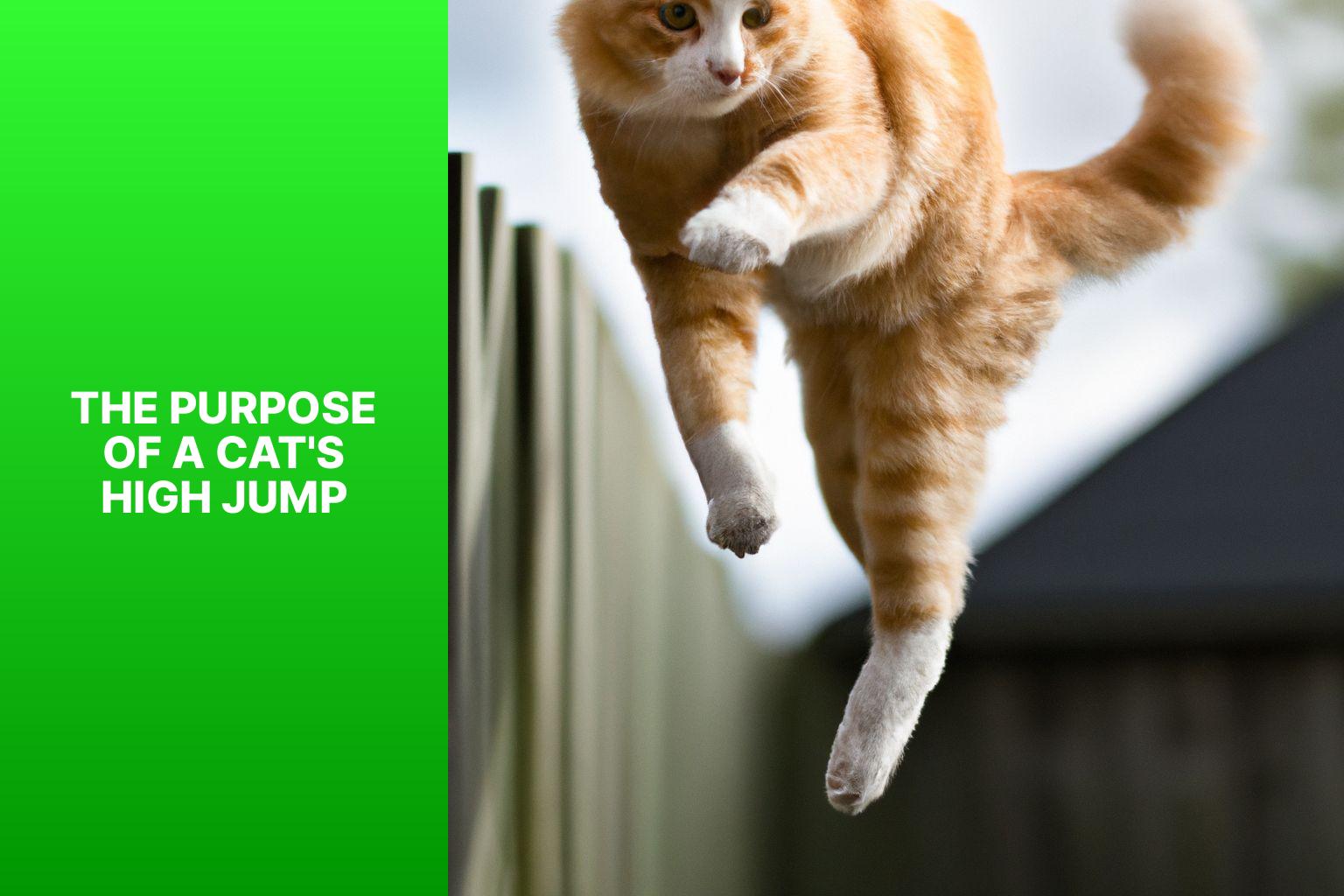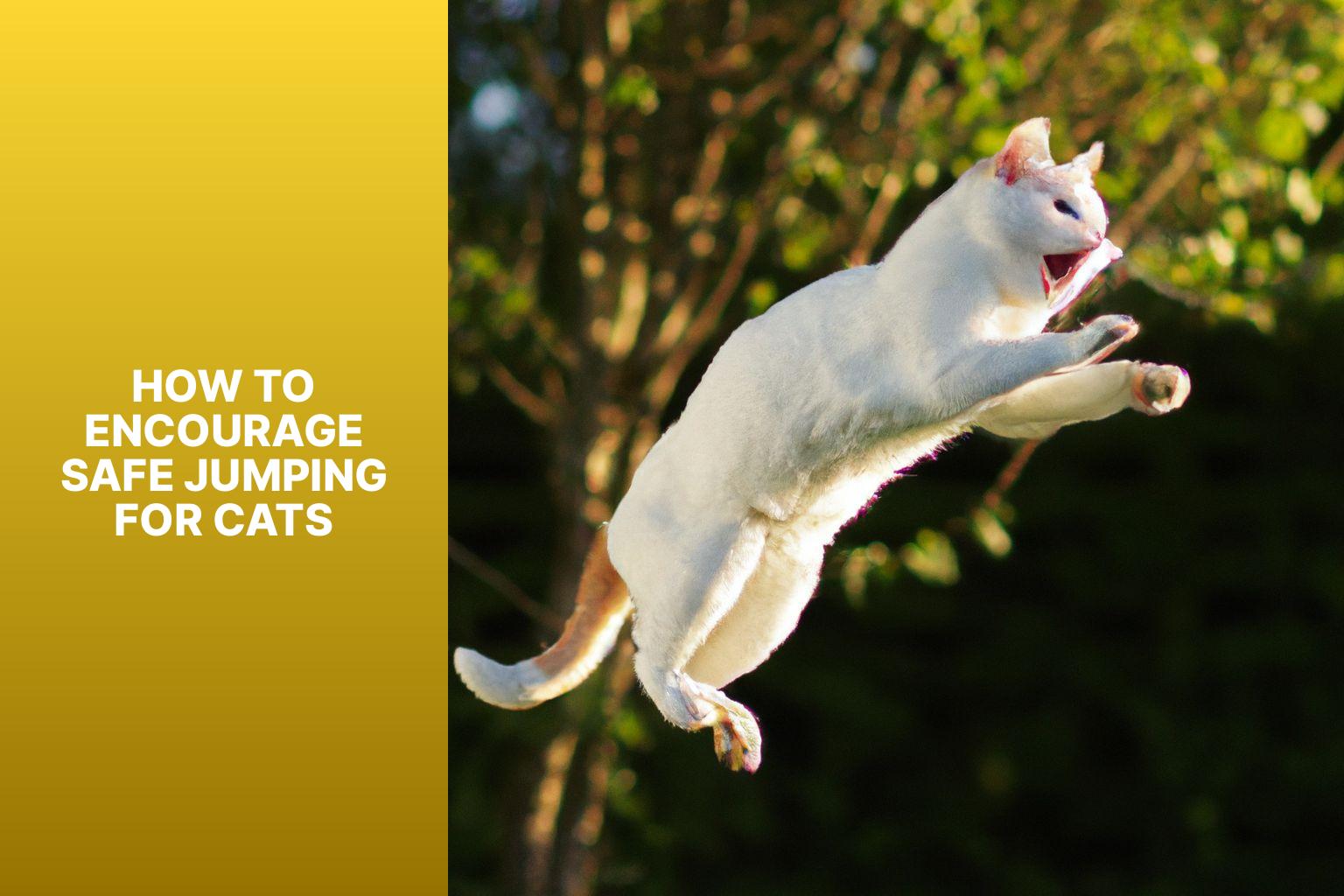Cats are known for their impressive jumping abilities, often leaving us in awe of their agility and grace. But just how high can a cat jump? The answer to this fascinating question lies in the unique anatomy and physiology of these feline athletes.
The precise mechanism behind a cat’s jump can be attributed to several factors. Their muscular hind legs provide the power needed to propel them upwards. Their flexible spine allows for a significant range of motion, enabling them to stretch and extend during a jump. Their strong paws and retractable claws act as gripping and landing mechanisms, ensuring a secure and stable jump.
While the general ability to jump is inherent in all cats, the height they can achieve can vary based on certain factors. The breed and size of a cat can influence their jumping abilities, with larger and more athletic breeds often capable of higher jumps. age and physical condition play a role, as younger and healthier cats tend to have more strength and agility for greater heights. Training and practice can also impact a cat’s jumping skills, with consistent exercise and playtime helping to improve their jumping prowess.
Recorded heights of cat jumps have astounded researchers and cat enthusiasts alike. Vertical jumps have been reported as high as 5 feet or more, while horizontal jumps have been observed spanning distances of 7 to 8 feet. These remarkable feats highlight the incredible athletic capabilities of our feline companions.
Understanding the purpose behind a cat’s high jump is key to appreciating this behavior. Cats are natural-born predators, and their jumping prowess enables them to reach elevated positions to observe their surroundings, hunt prey, or escape potential threats. It is an essential survival skill ingrained in their instincts since ancient times.
To encourage safe jumping for cats, certain measures can be taken. Providing vertical spaces such as perches, shelves, or cat trees allows cats to exercise their natural climbing and jumping behaviors. Regular exercise and playtime help cats maintain their physical fitness and harness their jumping abilities. And finally, safeguarding potential hazards such as fragile objects or open windows ensures that cats can jump in a secure and protected environment.
By gaining insight into how high cats can jump and appreciating the fascinating aspects of their anatomy and behavior, we can further deepen our bond with these incredible creatures and provide them with an environment that encourages their natural instincts.
Key takeaway:
- Cats can jump remarkably high: Due to their anatomical features such as muscular hind legs, a flexible spine, and strong paws and claws, cats are capable of impressive vertical and horizontal jumps.
- Factors influencing jumping height: Breed and size, age and physical condition, as well as training and practice play significant roles in determining a cat’s jumping ability.
- Promoting safe jumping for cats: Providing vertical spaces, engaging in regular exercise and playtime, and safeguarding against potential hazards are important for encouraging safe jumping behaviors in cats.
How High Can a Cat Jump?
How High Can a Cat Jump?
Cats can jump to impressive heights due to their muscular bodies and flexible joints. Height can vary based on factors like breed, age, and fitness level. On average, domestic cats can jump up to six times their body length in one leap. Smaller breeds can typically jump around four to five feet vertically, while larger breeds like the Maine Coon can reach heights of six feet or more. Cats are also skilled at jumping horizontally, covering distances of up to seven feet. It’s important to note that individual cats may have different abilities, and factors like physical condition and training can impact jumping prowess. When you see your cat effortlessly leaping onto high surfaces or chasing after a toy, you can appreciate their incredible jumping capabilities.
The Anatomy and Physiology of a Cat’s Jump
Cats possess remarkable agility and jumping abilities, and in this section, we will explore the fascinating anatomy and physiology behind a cat’s jump. From their muscular hind legs to their flexible spines and strong paws with claws, we will unravel the secrets that enable these graceful creatures to reach incredible heights. So, get ready to dive into the intriguing world of feline athleticism and discover the science behind their extraordinary jumping prowess.
Muscular Hind Legs
Muscular hind legs are crucial for a cat’s powerful jumps. Here are the key points highlighting the significance of a cat’s muscular hind legs:
- Cats possess robust thigh muscles that provide the required propulsion for their jumps.
- The muscles in their back legs play a critical role in generating the force necessary to launch a cat into the air.
- The activity of the thigh muscles contributes to a cat’s jumping prowess, enabling them to leap to impressive heights and cover remarkable distances.
- The muscular hind legs of cats allow them to execute vertical jumps, reaching impressive heights.
- Strong hind limbs enable cats to perform horizontal jumps, displaying grace and agility while covering long distances.
The muscular hind legs of a cat truly exemplify their athleticism and predatory instincts. They form an essential part of a cat’s anatomy, enabling them to explore their environment and find secure resting places.
Flexible Spine
The flexibility of a cat’s spine is crucial for its impressive jumping abilities. Here are some key points about a cat’s spine:
- Adaptability: A cat’s spine is flexible and consists of small vertebrae that allow for a wide range of movement. This flexibility enables cats to twist, turn, and contort their bodies easily.
- Enhanced Balance: The flexibility of the spine helps cats maintain balance while jumping, allowing them to adjust their body position in response to environmental changes or to ensure a successful landing.
- Increased Agility: The cat’s flexible spine contributes to its exceptional agility. The spine acts as a spring that stores and releases energy, propelling the cat higher and farther during jumps.
- Precision in Judging Distances: The cat’s flexible spine, combined with its predatory instincts, helps it accurately judge distances when jumping. This precision allows cats to make impressive leaps between surfaces.
Suggestions to maintain a healthy and flexible spine in cats:
- Regular exercise: Encourage your cat to engage in activities that promote movement, such as interactive play sessions or providing climbing structures. These activities help keep the spine supple and flexible.
- Comfortable resting places: Provide your cat with safe and elevated surfaces to rest and stretch, encouraging natural stretching and maintaining spine flexibility.
- Optimal nutrition: A balanced diet that includes essential nutrients supports overall spine health. Consult a veterinarian to ensure your cat’s diet meets its nutritional needs.
Remember, a cat’s flexible spine is a remarkable adaptation that allows them to exhibit their incredible jumping prowess. By understanding and nurturing their unique anatomy, we can help ensure they live healthy, active lives.
Strong Paws and Claws
Strong paws and claws play a crucial role in a cat’s jumping ability. These essential features enable the cat to generate substantial force from the ground and maintain stability throughout the jump.
Paw strength is facilitated by the robust muscles and tendons in a cat’s paws. These structures enable the cat to firmly grip surfaces and exert powerful propulsion. In addition, the pads on their paws contribute to traction, preventing slipping and ensuring balance.
The functioning of the claws is equally important. When a cat jumps, they utilize their claws to dig into surfaces, providing a secure grip. The sharpness of their claws allows them to effectively grasp objects like tree trunks or high shelves.
Cats possess the unique ability to retract their claws when not in use, which helps in preserving their sharpness and preventing wear. This retractability also enables them to swiftly extend and retract their claws, enabling quick adjustments during jumps.
The primary force behind a cat’s jump is exerted by their hind legs, which are supported by strong thigh muscles, paws, and claws. This powerful combination allows cats to propel themselves off the ground, achieving impressive heights and covering significant distances.
As a pro-tip, to satisfy a cat’s innate instinct to use their paws and claws, it is recommended to provide a scratching post or a cat tree with multiple levels for climbing and jumping. This will provide mental and physical stimulation, keeping them engaged and active.
Factors That Determine a Cat’s Jumping Height
Cats have always fascinated us with their incredible agility and graceful leaps. But have you ever wondered what factors influence a cat’s jumping height? In this section, we’ll uncover the secrets behind a cat’s impressive jumps. From the influence of breed and size to the impact of age and physical condition, we’ll explore how these factors shape a feline’s ability to soar through the air. Get ready to uncover the remarkable capabilities of our feline friends as we dive into the world of cat jumping heights.
Breed and Size
Breed and size significantly affect a cat’s jumping height. Here are some considerations:
1. Breed: Some cat breeds, like Abyssinians and Bengals, are known for their athleticism and jumping abilities. Maine Coons, with their large size, also have impressive jumping skills.
2. Size: Generally, larger cats can jump higher than smaller cats because of longer limbs, stronger muscles, and a higher muscle mass to body weight ratio.
3. Proportions: A cat’s body proportions, including longer hind limbs and a flexible spine, can contribute to its jumping ability. Breeds like the Oriental Shorthair and Siamese often have these advantageous traits.
4. Individual Factors: While breed and size give a general idea of a cat’s jumping potential, individual factors like age, physical condition, and training can also influence jumping height.
Considering your cat’s breed and size when creating vertical spaces and providing exercise and play opportunities can encourage safe and fulfilling jumping experiences. It’s important to prioritize their safety by removing potential hazards and offering a secure resting place after high jumps.
Age and Physical Condition
As cats age and their physical condition changes, their jumping abilities may be affected. Senior cats, with decreased muscle tone and strength, may experience difficulty in jumping. On the other hand, adult cats, who are at the peak of their physical abilities, can execute agile and graceful jumps. As for kittens, their jumping prowess may be limited due to their ongoing development and incomplete muscle and coordination development.
It is important to consider a cat’s age and physical condition when evaluating their jumping capabilities. Older cats may not be able to jump as high as younger cats because of age-related changes in their muscles and joints. Similarly, kittens may lack the strength and coordination required for high jumps. Providing appropriate exercise and playtime for cats of all ages can assist them in maintaining and enhancing their jumping skills and overall physical condition. Regular vet check-ups and proper cat health care also play a vital role in maintaining healthy muscles and joints, thus contributing to the improvement of a cat’s jumping abilities throughout their life.
Training and Practice
– Start training and practice early: Begin training your cat in basic commands and behaviors as soon as possible. This will establish good habits and make training and practice easier.
– Use positive reinforcement during training and practice: Reward your cat with treats or praise when they exhibit the desired behavior. Positive reinforcement during training and practice will motivate them to continue practicing.
– Break training and practice down: Divide complex tasks into smaller steps. This makes it easier for your cat to understand and learn the behavior you are teaching during training and practice.
– Be consistent with training and practice: Regularly practice training and be consistent with commands and expectations. This helps your cat understand what is expected and reinforces the desired behavior during training and practice.
– Patience is key during training and practice: Cats may take time to learn new behaviors and commands. Be patient and avoid getting frustrated. Training and practice should be a positive and enjoyable experience for both you and your cat.
One famous trained cat in history is Alley, who lived in 19th-century Chicago. Alley was trained and practiced by her owner, Samuel Nicholas, to perform impressive tricks and stunts. She could jump through hoops, walk on a tightrope, and even play a guitar. Alley’s performances were popular and featured in local media. Her training and talent made her a beloved and admired cat in the city. Alley’s legacy continues to inspire cat owners, showing that with the right training and practice, cats can achieve amazing feats.
Recorded Heights of Cat Jumps
Discover the astonishing heights that cats can achieve in their jumps! From vertical leaps to incredible horizontal distances, we dive into the realm of recorded cat jumps. Prepare to be amazed as we explore the sub-sections of vertical jumps and horizontal jumps, revealing the astounding capabilities of our feline friends. Join us on this thrilling journey of agility and grace as we uncover the remarkable feats achieved by these agile creatures.
Vertical Jumps
Vertical jumps are an impressive display of a cat’s athleticism and instincts. Here are some key points about vertical jumps:
- Cats can perform vertical jumps up to six times their body length.
- The highest recorded vertical jump by a domestic cat measured approximately six feet.
- Cats’ strong hind limbs and thigh muscles enable them to execute vertical jumps.
- Cats’ flexible spines allow for easy extension of their bodies, generating power for high jumps.
- Factors such as breed and size can impact a cat’s jumping ability, with larger and more muscular cats typically capable of higher jumps.
- A cat’s jumping prowess is influenced by their age, physical condition, and experience.
- Providing vertical spaces, such as cat trees and shelves, can enhance a cat’s vertical jumping skills.
- Regular exercise and playtime can strengthen a cat’s leg muscles and improve their jumping ability.
- It is crucial to ensure a cat’s safety by eliminating potential hazards and offering suitable resting places at elevated heights.
- Vertical jumps showcase a cat’s agility and natural abilities, contributing to both their physical and mental well-being.
Horizontal Jumps
When it comes to horizontal jumps, cats demonstrate impressive agility and precision. Here are key factors to consider:
1. Muscular hind legs: Cats use powerful hind legs to generate force for horizontal jumps.
2. Flexible spines: Cats twist and turn their bodies mid-air, aided by their flexible spines, improving their horizontal jumping abilities.
3. Judgment of distances: Cats have remarkable depth perception and can accurately judge the distance required for a horizontal jump.
4. Thigh muscle activity: Strong thigh muscles enable cats to propel themselves forward with explosive speed during horizontal jumps.
5. Back leg muscles: The muscles in their back legs contribute to the cat’s ability to quickly push off the ground for a horizontal jump.
These factors allow cats to execute impressive horizontal jumps, whether it’s chasing prey or leaping between furniture. Watching their athletic prowess in action is truly fascinating!
The Purpose of a Cat’s High Jump
Photo Credits: Www.Catcornerblog.Com by Jose Johnson
The purpose of a cat’s high jump is multifaceted. It allows them to hunt effectively, defend themselves, exercise, and display their dominance.
Cats, being natural predators, have the advantage of being able to jump high. Their quick reflexes and strong hind legs enable them to pounce on prey with precision and speed. When faced with a threat, cats leap to higher ground to escape danger, using their vertical leap to reach places inaccessible to other animals.
Jumping also serves as a form of exercise, helping cats stay fit and agile, enhancing their overall proficiency. A high leap can demonstrate a cat’s dominance in a specific territory and establish their presence among other cats.
…
How to Encourage Safe Jumping for Cats
Photo Credits: Www.Catcornerblog.Com by Joseph Taylor
Encourage your feline friend to soar to new heights with safe jumping techniques! Discover how to provide vertical spaces, incorporate regular exercise and playtime, and safeguard against potential hazards. Your cat’s natural instincts and agility will be celebrated as they navigate their environment with confidence. Let’s explore these strategies to ensure your furry companion can jump safely and enjoy the exhilarating adventures that await them!
Providing Vertical Spaces
When it comes to vertical spaces for cats, consider the following factors:
1. Height: The vertical space should be tall enough for the cat to fully stretch. A minimum height of 6 feet is recommended.
2. Stability: The vertical space should be stable and secure, avoiding wobbling or tipping when the cat jumps or climbs.
3. Variety: Offer cat trees, shelves, or wall-mounted perches to provide different resting, observing, or playing spots.
4. Climbing options: Include platforms, ramps, or stairs to allow the cat to explore different levels of elevation.
5. Scratching surfaces: Integrate scratching posts or surfaces to satisfy the cat’s instinct to scratch and exercise their claws.
6. Accessibility: Ensure that the vertical space is easily accessible, especially for older or less mobile cats. Use ramps or steps to assist them in reaching higher levels.
7. Safety measures: Remove any hazards or potential dangers around the vertical space. Secure loose cords or objects that could harm the cat.
By providing vertical spaces that meet these criteria, you can enhance your cat’s environment and provide opportunities for exercise, mental stimulation, and a safe resting place.
Regular Exercise and Playtime
Regular exercise and playtime are essential for the overall health and well-being of cats. It is crucial to incorporate physical activities into their daily routine to help them maintain a healthy weight and prevent obesity, which can lead to various health issues. Playtime not only stimulates their mind but also prevents boredom, reducing the chances of destructive behavior.
For cats, it is recommended to have at least 15-30 minutes of playtime every day. To encourage physical activity and engage their hunting instincts, interactive toys like feather wands or laser pointers can be used. It is important to dedicate specific time each day to play with your cat and ensure they have an outlet for their energy. During play sessions, it is beneficial to include aerobic exercises to increase heart rate and muscle strength.
To keep cats active and entertained, climbing structures, scratching posts, and toys that promote jumping and running should be provided. Varying the play activities will keep it interesting and prevent boredom. Regular exercise and playtime also contribute to strengthening the bond between you and your cat.
To ensure a safe play environment, it is important to remove any potential hazards that could cause injury. Supervision during play sessions is necessary, and it is essential to avoid using toys that can be swallowed or pose a choking hazard. After playtime, providing a safe and comfortable resting place for your cat to recover and relax is essential.
Safeguarding Potential Hazards
Secure furniture, shelves, and other objects to prevent tipping or falling on the cat.
Store cleaning products, medications, and other toxic substances in inaccessible cabinets or areas to prevent accidental ingestion and poisoning.
Install window screens or netting to prevent cats from falling out of windows or balconies and create a safe environment for them to enjoy the view.
Tie up or cover electrical cords to prevent cats from chewing on them, which can lead to electric shocks or injuries.
Keep small objects, such as toys, coins, or buttons, out of the cat’s reach to prevent choking hazards or intestinal blockages.
- In 2019, a family in Indiana experienced a harrowing incident when their cat got stuck on the roof after climbing up the chimney. The family heard meowing coming from above and quickly contacted the local animal rescue. The rescue used a ladder to safely retrieve the cat. This incident emphasizes the importance of securing chimneys and other potential hazards to prevent accidents. Thanks to the family’s quick thinking and the actions of the animal rescue, the cat escaped unharmed and now enjoys a safer environment.
Some Facts About How High Can a Cat Jump:
- ✅ Cats have the ability to jump up to 9 times their own height. (Source: Our Team)
- ✅ The average height a cat can jump is about 6-8 feet. (Source: Our Team)
- ✅ Cats’ powerful leg muscles and flexible spines allow them to achieve impressive jumping skills. (Source: Our Team)
- ✅ Kittens have lower jumping capabilities compared to adult cats due to their developing strength and balance. (Source: Our Team)
- ✅ Factors such as age, breed, and health can influence a cat’s jumping ability. (Source: Our Team)




